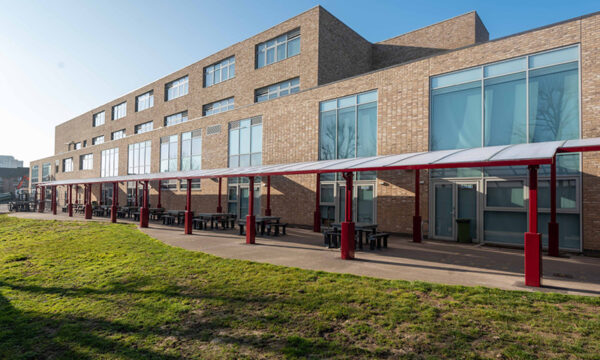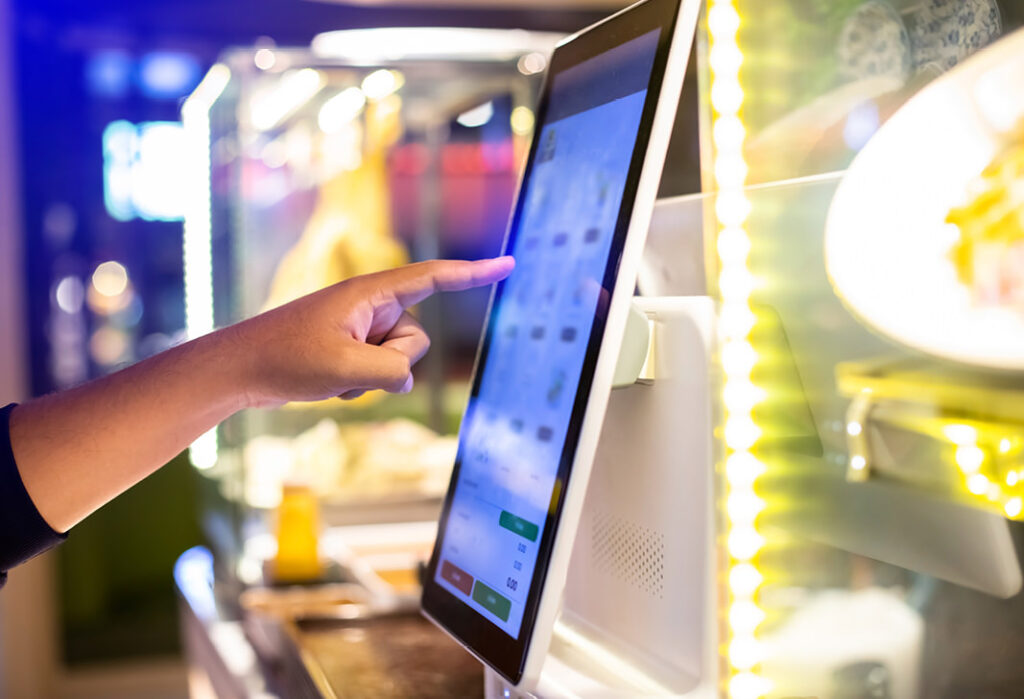
Canopies & Walkways
- All Canopies & Walkways
- Fabric Canopies
-
Polycarbonate Roof
Canopies - Covered Walkways
- Enclosed Canopies
- MUGA Canopies
- Timber Canopies
- Entrance Canopies

School dining design: A barrier for FSM pupils?
Pupils in receipt of free school meals (FSM) face multiple barriers in accessing their full entitlement, often feeling stigmatised or disadvantaged when it comes to school lunchtimes and the dining offer. Unfortunately, this can be exacerbated by poor design of lunchtime dining areas, queuing and payment systems in school.
The Child Poverty Action Group report the experiences of a range of pupils who are eligible for FSM. “Free school meal children are treated differently. [My daughter] is told she can’t buy certain foods on free school meals. It’s like wearing a big badge saying, ‘I’m poor’. It’s heart breaking to watch her come home hungry as she would rather not go into the lunch hall than have peers laugh at her.” (Parent)
Some schools restrict FSM use to lunchtime, preventing pupils from eating at breaktime even if they would prefer to. If the cost of food exceeds the FSM allowance or there are insufficient funds, pupils may be asked to return items at the till where traditional payment points are still in place. Unclear pricing means FSM pupils often do not know what they can afford until they reach the till.
In a recent study on FSM, some recipients remarked that the portion size of free school meals was “smaller than other people’s” and that their choice was also limited within the allowance. They also described the stigma and “how obvious it is”, with learners regularly having to ask the price of each item or being refused an item because they “can’t afford” it. Comments on free school meals generally included bullying, stigma and feelings of isolation.

The Food Foundation, in their study, ‘Feed the Future’, found that there are different ways in which children receiving FSM can claim their meals at school, including electronic payment cards, fingerprint systems, paper vouchers or by saying their names or numbers at the till. “I think it’s the most mortifying experience I’ve ever had because they make it incredibly obvious that you can’t afford your lunch”, reflected a fifteen-year-old pupil in the study.
Well-intentioned lanyards, FSM vouchers; any visual indicator of the child’s right to a free school meal actually feel more like a barrier; contributing to bottlenecks in already crowded queue systems. FSM pupils are left feeling hungry, embarrassed or both.
For this reason, physical tokens have generally been replaced with electronic cards or fingerprint-based systems, but the study notes that auto-enrolment would also be a particularly helpful way to ensure anonymity, so long as pupils are not constantly finding their automatic payment does not cover a reasonable meal.
The growing body of research states that helping to improve young people’s lunchtime experience will help them to learn, socialise and thrive. Fortunately, secondary schools can make small changes in their approach to food which can make a big difference to pupils. Interestingly, there is much to learn from how fast-food restaurants manage flow in their dining spaces. Specialist school providers, Beacon School Support, share tips on how thinking like McDonald’s can improve school dining with a particular focus on speed and lack of waiting time.

Despite being one of the most recognised brands on the planet, McDonald’s is known for continuous innovation. Since its opening in 1955, the golden arches have gone through numerous changes, redesigns and upgrades. None of these changes have been as impactful as the shift of McDonald’s towards the self-service kiosk ordering model.
Using self-service is said to give the customer control over their browse and order time frame, rather than being subject to the speed of the queue. Customers are given full control over order and customisation; not rushed or pressured to make a decision. The feeling of control that self-service gives, enhances customer experience by reducing interaction anxiety.
This self-service model could be an especially powerful tool if applied effectively in schools but must consider pupils in receipt of FSM, additional needs and those with dietary requirements: how might a self-service model look and feel for these pupils? It would certainly take away the stigma associated with having to walk past peers to return items or present a glaring yellow card with ‘FREE’ emblazoned across it. More and more schools are switching to this model. The results, when coupled with well-designed, open dining spaces, have been transformative.
Find out about The Regis School, whose business manager, Mark Betts, previously worked with McDonald’s and has learned a lot from their dining model.
Before working with Streetpace Structures, lunchtimes were becoming an increasing problems at The Regis School. Overcrowding, excessive queuing and an outdated dining hall with capacity limited to just 400 pupils, meant that the lunchtime offering was well below par. Vulnerable groups of pupils including those in receipt of FSM, were facing the additional barriers outlined, linked to queuing, time pressures and payment.

Mark credits the amazing turnaround of 1600 pupils, now dining in just 22 minutes, at The Regis School, to his fast-food restaurant approach in a brand-new space, expertly designed to ease lunchtime ‘pain points’, by Streetspace Structures. The new dining facilities allow for the self-service model to really shine; pupils pass through the spacious dining area easily, calmly and with a dramatic reduction in lunchtime behavioural incidents. [Read the full case study here]
Streetspace Structures were delighted to visit The Regis School, some months after the installation was complete, to see the new space in action during a living, breathing school lunchtime. It was immediately clear how well the new facilities allow for efficient flow and self-service, largely benefitting pupils in receipt of FSM, who were able to access their lunch in exactly the same way as their peers